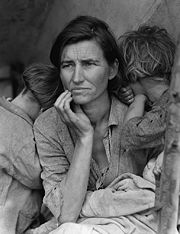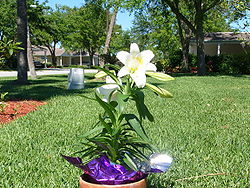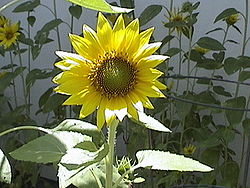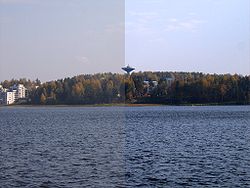
Image editing
Encyclopedia

Image
An image is an artifact, for example a two-dimensional picture, that has a similar appearance to some subject—usually a physical object or a person.-Characteristics:...
s, whether they be digital photograph
Digital photography
Digital photography is a form of photography that uses an array of light sensitive sensors to capture the image focused by the lens, as opposed to an exposure on light sensitive film...
s, traditional analog photograph
Photographic processing
Photographic processing is the chemical means by which photographic film and paper is treated after photographic exposure to produce a negative or positive image...
s, or illustration
Illustration
An illustration is a displayed visualization form presented as a drawing, painting, photograph or other work of art that is created to elucidate or dictate sensual information by providing a visual representation graphically.- Early history :The earliest forms of illustration were prehistoric...
s. Traditional analog image editing is known as photo retouching, using tools such as an airbrush
Airbrush
An airbrush is a small, air-operated tool that sprays various media including ink and dye, but most often paint by a process of nebulization. Spray guns developed from the airbrush and are still considered a type of airbrush.-History:...
to modify photographs, or editing illustrations with any traditional art medium. Graphic software programs, which can be broadly grouped into vector graphics editor
Vector graphics editor
A vector graphics editor is a computer program that allows users to compose and edit vector graphics images interactively on a computer and save them in one of many popular vector graphics formats, such as EPS, PDF, WMF, SVG, or VML....
s, raster graphics editor
Raster graphics editor
A raster graphics editor is a computer program that allows users to paint and edit pictures interactively on the computer screen and save them in one of many popular “bitmap” or “raster” formats such as JPEG, PNG, GIF and TIFF....
s, and 3d modelers, are the primary tools with which a user may manipulate, enhance, and transform images. Many image editing programs are also used to render
Artistic rendering
Rendering in visual art and technical drawing means the process of creating, shading, and texturing of an image, especially a photorealistic one. It can also be used to describe the quality of execution of that process...
or create computer art
Computer art
Computer art is any art in which computers play a role in production or display of the artwork. Such art can be an image, sound, animation, video, CD-ROM, DVD-ROM, videogame, web site, algorithm, performance or gallery installation...
from scratch.
Basics of image editing
RasterRaster graphics
In computer graphics, a raster graphics image, or bitmap, is a data structure representing a generally rectangular grid of pixels, or points of color, viewable via a monitor, paper, or other display medium...
images are stored in a computer in the form of a grid of picture elements, or pixels. These pixels contain the image's color and brightness information. Image editors can change the pixels to enhance the image in many ways. The pixels can be changed as a group, or individually, by the sophisticated algorithms within the image editors. The domain of this article primarily refers to bitmap
Bitmap
In computer graphics, a bitmap or pixmap is a type of memory organization or image file format used to store digital images. The term bitmap comes from the computer programming terminology, meaning just a map of bits, a spatially mapped array of bits. Now, along with pixmap, it commonly refers to...
graphics editors, which are often used to alter photographs and other raster graphics. However, vector graphics
Vector graphics
Vector graphics is the use of geometrical primitives such as points, lines, curves, and shapes or polygon, which are all based on mathematical expressions, to represent images in computer graphics...
software, such as Adobe Illustrator
Adobe Illustrator
Adobe Illustrator is a vector graphics editor developed and marketed by Adobe Systems. Illustrator is similar in scope, intended market, and functionality to its competitors, CorelDraw, Xara Designer Pro and Macromedia FreeHand....
or Inkscape
Inkscape
Inkscape is a free software vector graphics editor, licensed under the GNU General Public License. Its goal is to implement full support for the Scalable Vector Graphics 1.1 standard....
, are used to create and modify vector images, which are stored as descriptions of lines
Line (geometry)
The notion of line or straight line was introduced by the ancient mathematicians to represent straight objects with negligible width and depth. Lines are an idealization of such objects...
, Bézier splines, and text
Plain text
In computing, plain text is the contents of an ordinary sequential file readable as textual material without much processing, usually opposed to formatted text....
instead of pixels. It is easier to rasterize a vector image than to vectorize a raster image; how to go about vectorizing a raster image is the focus of much research in the field of computer vision
Computer vision
Computer vision is a field that includes methods for acquiring, processing, analysing, and understanding images and, in general, high-dimensional data from the real world in order to produce numerical or symbolic information, e.g., in the forms of decisions...
. Vector images can be modified more easily, because they contain descriptions of the shapes for easy rearrangement. They are also scalable, being rasterizable at any resolution
Image resolution
Image resolution is an umbrella term that describes the detail an image holds. The term applies to raster digital images, film images, and other types of images. Higher resolution means more image detail....
.
Automatic image enhancement
Camera or computer image editing programs often offer basic automatic image enhancement features that correct color hueHue
Hue is one of the main properties of a color, defined technically , as "the degree to which a stimulus can be describedas similar to or different from stimuli that are described as red, green, blue, and yellow,"...
and brightness imbalances as well as other image editing features, such as red eye
Red-eye effect
The red-eye effect in photography is the common appearance of red pupils in color photographs of eyes. It occurs when using a photographic flash very close to the camera lens , in ambient low light. The effect appears in the eyes of humans and animals that have no tapetum lucidum, hence no...
removal, sharpness adjustments, zoom
Digital zoom
Digital zoom is a method of decreasing the apparent angle of view of a digital photographic or video image. Digital zoom is accomplished by cropping an image down to a centered area with the same aspect ratio as the original, and usually also interpolating the result back up to the pixel...
features and automatic cropping. These are called automatic because generally they happen without user interaction or are offered with one click of a button or mouse button or by selecting an option from a menu. Additionally, some automatic editing features offer a combination of editing actions with little or no user interaction.
Digital data compression
Many image file formats use data compressionData compression
In computer science and information theory, data compression, source coding or bit-rate reduction is the process of encoding information using fewer bits than the original representation would use....
to reduce file size and save storage space. Digital compression of images may take place in the camera, or can be done in the computer with the image editor. When images are stored in JPEG
JPEG
In computing, JPEG . The degree of compression can be adjusted, allowing a selectable tradeoff between storage size and image quality. JPEG typically achieves 10:1 compression with little perceptible loss in image quality....
format, compression has already taken place. Both cameras and computer programs allow the user to set the level of compression.
Some compression algorithms, such as those used in PNG file format, are lossless, which means no information is lost when the file is saved. By contrast, the JPEG
JPEG
In computing, JPEG . The degree of compression can be adjusted, allowing a selectable tradeoff between storage size and image quality. JPEG typically achieves 10:1 compression with little perceptible loss in image quality....
file format uses a lossy compression algorithm by which the greater the compression, the more information is lost, ultimately reducing image quality or detail that can not be restored. JPEG uses knowledge of the way the human brain and eyes perceive color to make this loss of detail less noticeable.
Image editor features
Listed below are some of the most used capabilities of the better graphic manipulation programs. The list is by no means all inclusive. There are a myriad of choices associated with the application of most of these features.Selection
One of the prerequisites for many of the applications mentioned below is a method of selectingSelection (user interface)
In computing and user interface engineering, a selection is a list of items on which user operations will take place. The user typically adds items to the list manually, although the computer may create a selection automatically. A precision pointing device or by hand on a touchscreen device is...
part(s) of an image, thus applying a change selectively without affecting the entire picture. Most graphics programs have several means of accomplishing this, such as a marquee tool, lasso tool, magic wand tool, vector-based pen tools as well as more advanced facilities such as edge detection, masking, alpha compositing, and color and channel-based extraction.
Layers
Another feature common to many graphics applications is that of LayersLayers (digital image editing)
Layers are used in digital image editing to separate different elements of an image. A layer can be compared to a transparency on which imaging effects or images are applied and placed over or under an image...
, which are analogous to sheets of transparent acetate
Cellulose acetate
Cellulose acetate , first prepared in 1865, is the acetate ester of cellulose. Cellulose acetate is used as a film base in photography, as a component in some adhesives, and as a frame material for eyeglasses; it is also used as a synthetic fiber and in the manufacture of cigarette filters and...
(each containing separate elements that make up a combined picture), stacked on top of each other, each capable of being individually positioned, altered and blended with the layers below, without affecting any of the elements on the other layers. This is a fundamental workflow which has become the norm for the majority of programs on the market today, and enables maximum flexibility for the user while maintaining non-destructive editing
Non-destructive editing
Non-destructive editing is a form of editing signals where the original content is not modified in the course of editing—instead the edits themselves are edited by video editing software on a non-linear editing system ....
principles and ease of use.
Image size alteration
Image editors can resize images in a process often called image scalingImage scaling
In computer graphics, image scaling is the process of resizing a digital image. Scaling is a non-trivial process that involves a trade-off between efficiency, smoothness and sharpness. As the size of an image is increased, so the pixels which comprise the image become increasingly visible, making...
, making them larger, or smaller. High image resolution
Image resolution
Image resolution is an umbrella term that describes the detail an image holds. The term applies to raster digital images, film images, and other types of images. Higher resolution means more image detail....
cameras can produce large images which are often reduced in size for Internet
Internet
The Internet is a global system of interconnected computer networks that use the standard Internet protocol suite to serve billions of users worldwide...
use. Image editor programs use a mathematical process called resampling to calculate new pixel values whose spacing is larger or smaller than the original pixel values. Images for Internet use are kept small, say 640 x 480 pixels which would equal 0.3 megapixels
Pixel
In digital imaging, a pixel, or pel, is a single point in a raster image, or the smallest addressable screen element in a display device; it is the smallest unit of picture that can be represented or controlled....
.
Cropping an image
Digital editors are used to crop imagesCropping (image)
Cropping refers to the removal of the outer parts of an image to improve framing, accentuate subject matter or change aspect ratio. Depending on the application, this may be performed on a physical photograph, artwork or film footage, or achieved digitally using image editing software...
. Cropping creates a new image by selecting a desired rectangular portion from the image being cropped. The unwanted part of the image is discarded. Image cropping does not reduce the resolution of the area cropped. Best results are obtained when the original image has a high resolution. A primary reason for cropping is to improve the image composition in the new image.
 |
 |
Histogram
Image editors have provisions to create an image histogramImage histogram
An image histogram is a type of histogram that acts as a graphical representation of the tonal distribution in a digital image. It plots the number of pixels for each tonal value. By looking at the histogram for a specific image a viewer will be able to judge the entire tonal distribution at a...
of the image being edited. The histogram plots the number of pixels in the image (vertical axis) with a particular brightness value (horizontal axis). Algorithms in the digital editor allow the user to visually adjust the brightness value of each pixel and to dynamically display the results as adjustments are made. Improvements in picture brightness and contrast can thus be obtained.
 |
 |
Noise reduction
Image editors may feature a number of algorithms which can add or remove noiseImage noise
Image noise is random variation of brightness or color information in images, and is usually an aspect of electronic noise. It can be produced by the sensor and circuitry of a scanner or digital camera...
in an image. JPEG
JPEG
In computing, JPEG . The degree of compression can be adjusted, allowing a selectable tradeoff between storage size and image quality. JPEG typically achieves 10:1 compression with little perceptible loss in image quality....
artifacts can be removed; dust and scratches can be removed and an image can be de-speckled. Noise reduction merely estimates the state of the scene without the noise and is not a substitute for obtaining a "cleaner" image. Excessive noise reduction leads to a loss of detail, and its application is hence subject to a trade-off between the undesirability of the noise itself and that of the reduction artifacts.
Noise tends to invade images when pictures are taken in low light settings. A new picture can be given an 'antiquated' effect by adding uniform monochrome noise.
Removal of unwanted elements
Most image editors can be used to remove unwanted branches, etc., using a "clone" tool. Removing these distracting elements draws focus to the subject, improving overall compositionComposition (visual arts)
In the visual arts – in particular painting, graphic design, photography and sculpture – composition is the placement or arrangement of visual elements or ingredients in a work of art or a photograph, as distinct from the subject of a work...
.
 |
 |
Selective color change
Some image editors have color swapping abilities to selectively change the color of specific items in an image, given that the selected items are within a specific color range.
Image orientation

Mirror image
A mirror image is a reflected duplication of an object that appears identical but reversed. As an optical effect it results from reflection off of substances such as a mirror or water. It is also a concept in geometry and can be used as a conceptualization process for 3-D structures...
s can be created and images can be horizontally flipped
Flipped image
A flipped image or reversed image, the more formal term, is a static or moving image that is generated by a mirror-reversal of an original across a horizontal axis...
or vertically flopped. A small rotation of several degree
Degree (angle)
A degree , usually denoted by ° , is a measurement of plane angle, representing 1⁄360 of a full rotation; one degree is equivalent to π/180 radians...
s is often enough to level the horizon
Horizon
The horizon is the apparent line that separates earth from sky, the line that divides all visible directions into two categories: those that intersect the Earth's surface, and those that do not. At many locations, the true horizon is obscured by trees, buildings, mountains, etc., and the resulting...
, correct verticality
Vertical direction
In astronomy, geography, geometry and related sciences and contexts, a direction passing by a given point is said to be vertical if it is locally aligned with the gradient of the gravity field, i.e., with the direction of the gravitational force at that point...
(of a building, for example), or both. Rotated images usually require cropping
Cropping (image)
Cropping refers to the removal of the outer parts of an image to improve framing, accentuate subject matter or change aspect ratio. Depending on the application, this may be performed on a physical photograph, artwork or film footage, or achieved digitally using image editing software...
afterwards, in order to remove the resulting gaps at the image edges.
Perspective control and distortion
Some image editors allow the user to distortDistortion
A distortion is the alteration of the original shape of an object, image, sound, waveform or other form of information or representation. Distortion is usually unwanted, and often many methods are employed to minimize it in practice...
(or "transform") the shape of an image. While this might also be useful for special effects, it is the preferred method of correcting the typical perspective
Perspective (graphical)
Perspective in the graphic arts, such as drawing, is an approximate representation, on a flat surface , of an image as it is seen by the eye...
distortion which results from photographs being taken at an oblique angle to a rectilinear
Rectilinear
Rectilinear may refer to:* Rectilinear grid, a tessellation of the Euclidean plane* Rectilinear lens, a photographic lens* Rectilinear locomotion, a form of animal locomotion* Rectilinear polygon, a polygon whose edges meet at right angles...
subject. Care is needed while performing this task, as the image is reprocessed using interpolation
Interpolation
In the mathematical field of numerical analysis, interpolation is a method of constructing new data points within the range of a discrete set of known data points....
of adjacent pixels, which may reduce overall image definition
Definition
A definition is a passage that explains the meaning of a term , or a type of thing. The term to be defined is the definiendum. A term may have many different senses or meanings...
. The effect mimics the use of a perspective control lens, which achieves a similar correction in-camera
In-camera effect
An in-camera effect is any special effect in a video or movie that is created solely by using techniques in and on the camera and/or its parts. The in-camera effect is defined by the fact that the effect exists on the original camera negative or video recording before it is sent to a lab or modified...
without loss of definition.
Lens correction
Photo manipulation packages have functions to correct images for various lens distortions including pincushion, fisheyeFisheye lens
In photography, a fisheye lens is a wide-angle lens that takes in a broad, panoramic and hemispherical image. Originally developed for use in meteorology to study cloud formation and called "whole-sky lenses", fisheye lenses quickly became popular in general photography for their unique, distorted...
and barrel distortions. The corrections are in most cases subtle, but can improve the appearance of some photographs.
Enhancing images
In computer graphicsComputer graphics
Computer graphics are graphics created using computers and, more generally, the representation and manipulation of image data by a computer with help from specialized software and hardware....
, the process of improving the quality of a digitally stored image by manipulating the image with software. It is quite easy, for example, to make an image lighter or darker, or to increase or decrease contrast. Advanced photo enhancement software also supports many filters for altering images in various ways. Programs specialized for image enhancement are sometimes called image editors.
Sharpening and softening images
Graphics programs can be used to both sharpen and blur images in a number of ways, such as unsharp masking or deconvolution. Portraits often appear more pleasing when selectively softened (particularly the skin and the background) to better make the subject stand out. This can be achieved with a camera by using a large apertureAperture
In optics, an aperture is a hole or an opening through which light travels. More specifically, the aperture of an optical system is the opening that determines the cone angle of a bundle of rays that come to a focus in the image plane. The aperture determines how collimated the admitted rays are,...
, or in the image editor by making a selection and then blurring it. Edge enhancement
Edge enhancement
Edge enhancement is an image processing filter that enhances the edge contrast of an image or video in an attempt to improve its acutance ....
is an extremely common technique used to make images appear sharper, although purists frown on the result as appearing unnatural.
Selecting and merging of images
Many graphics applications are capable of merging one or more individual images into a single file. The orientation and placement of each image can be controlled.When selecting a raster image that is not rectangular, it requires separating the edges from the background, also known as silhouetting. This is the digital version of cutting out the image. Clipping path
Clipping path
A clipping path is a closed vector path, or shape, used to cut out a 2D image in image editing software. Anything inside the path will be included after the clipping path is applied; anything outside the path will be omitted from the output...
s may be used to add silhouetted images to vector graphics or page layout files that retain vector data. Alpha compositing
Alpha compositing
In computer graphics, alpha compositing is the process of combining an image with a background to create the appearance of partial or full transparency. It is often useful to render image elements in separate passes, and then combine the resulting multiple 2D images into a single, final image in a...
, allows for soft translucent edges when selecting images. There are a number of ways to silhouette an image with soft edges including selecting the image or its background by sampling similar colors, selecting the edges by raster tracing, or converting a clipping path to a raster selection. Once the image is selected, it may be copied and pasted into another section of the same file, or into a separate file. The selection may also be saved in what is known as an alpha channel.
A popular way to create a composite image is to use transparent layers
Layers (digital image editing)
Layers are used in digital image editing to separate different elements of an image. A layer can be compared to a transparency on which imaging effects or images are applied and placed over or under an image...
. The background image is used as the bottom layer, and the image with parts to be added are placed in a layer above that. Using an image layer mask, all but the parts to be merged are hidden from the layer, giving the impression that these parts have been added to the background layer. Performing a merge in this manner preserves all of the pixel data on both layers to more easily enable future changes in the new merged image.
Slicing of images
A more recent tool in digital image editing software is the image slicer. Parts of images for graphical user interfaces or web pages are easily sliced, labeled and saved separately from whole images so the parts can be handled individually by the display medium. This is useful to allow dynamic swapping via interactivity or animating parts of an image in the final presentation.Special effects

Image editors usually have a list of special effects that can create unusual results. Images may be skewed and distorted in various ways. Scores of special effects can be applied to an image which include various forms of distortion, artistic effects, geometric transforms and texture effects, or combinations thereof.
Change color depth

Color depth
In computer graphics, color depth or bit depth is the number of bits used to represent the color of a single pixel in a bitmapped image or video frame buffer. This concept is also known as bits per pixel , particularly when specified along with the number of bits used...
of images. Common color depths are 2, 4, 16, 256, 65,536 and 16.7 million colors. The JPEG and PNG image formats are capable of storing 16.7 million colors (equal to 256 luminance values per color channel). In addition, grayscale
Grayscale
In photography and computing, a grayscale or greyscale digital image is an image in which the value of each pixel is a single sample, that is, it carries only intensity information...
images of 8 bit
Bit
A bit is the basic unit of information in computing and telecommunications; it is the amount of information stored by a digital device or other physical system that exists in one of two possible distinct states...
s or less can be created, usually via conversion and down-sampling from a full-color image.
Contrast change and brightening

Luminosity
Luminosity is a measurement of brightness.-In photometry and color imaging:In photometry, luminosity is sometimes incorrectly used to refer to luminance, which is the density of luminous intensity in a given direction. The SI unit for luminance is candela per square metre.The luminosity function...
threshold are brightened, thereby brightening underexposed shadows without affecting the rest of the image.
The exact transformation that is applied to each color channel can vary from editor to editor. GIMP
GIMP
GIMP is a free software raster graphics editor. It is primarily employed as an image retouching and editing tool and is freely available in versions tailored for most popular operating systems including Microsoft Windows, Apple Mac OS X, and Linux.In addition to detailed image retouching and...
applies the following formula:
if (brightness < 0.0) value = value * ( 1.0 + brightness);
else value = value + ((1 - value) * brightness);
value = (value - 0.5) * (tan ((contrast + 1) * PI/4) ) + 0.5;
where value is the input color value in the 0..1 range and brightness and contrast are in the -1..1 range.
Gamma correction
In addition to the capability of changing the images' brightness and/or contrast, most current image editors provide an opportunity to manipulate the images' gamma valueGamma correction
Gamma correction, gamma nonlinearity, gamma encoding, or often simply gamma, is the name of a nonlinear operation used to code and decode luminance or tristimulus values in video or still image systems...
.
Color adjustments

Curve (tonality)
In image editing, a curve is a remapping of image tonality, specified as a function from input level to output level, used as a way to emphasize colours or other elements in a picture....
or other tools. The color balance can be improved, which is important if the picture was shot indoors with daylight film, or shot on a camera with the white balance incorrectly set. Special effects, like sepia and grayscale, can be added to an image. In addition, more complicated procedures such as the mixing of color channels are possible using more advanced graphics editors.
The red-eye effect
Red-eye effect
The red-eye effect in photography is the common appearance of red pupils in color photographs of eyes. It occurs when using a photographic flash very close to the camera lens , in ambient low light. The effect appears in the eyes of humans and animals that have no tapetum lucidum, hence no...
, which occurs when flash photos are taken when the pupil is too widely open (so that light from the flash that passes into the eye through the pupil reflects off the fundus at the back of the eyeball), can also be eliminated at this stage.
Printing


